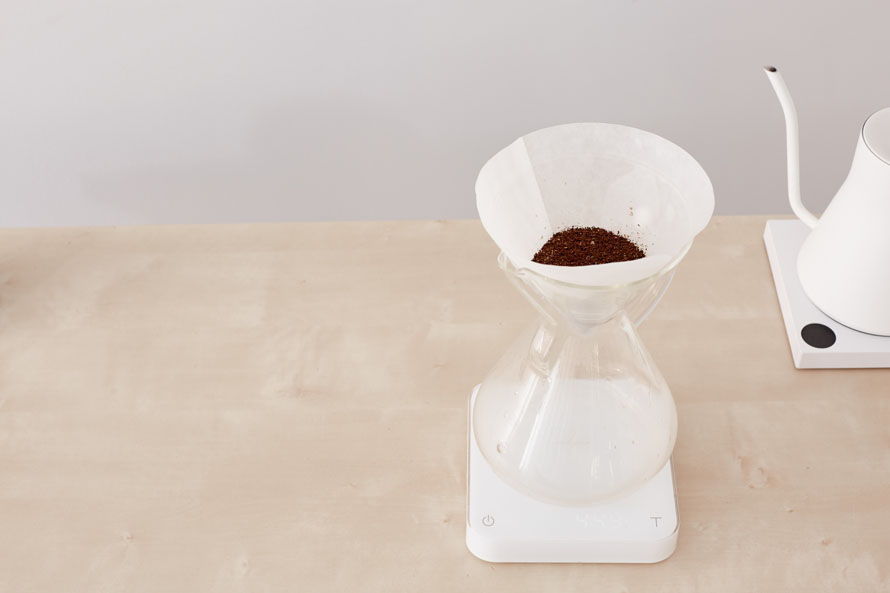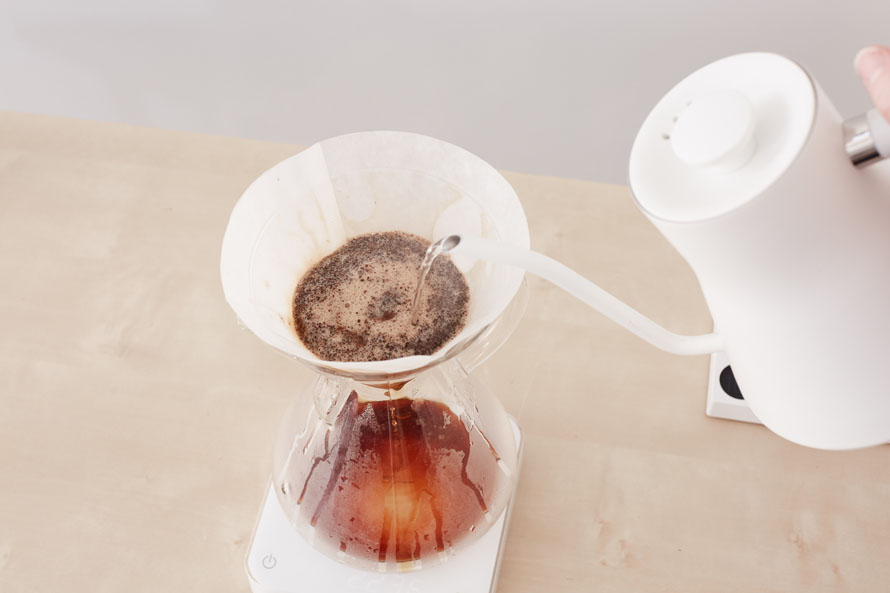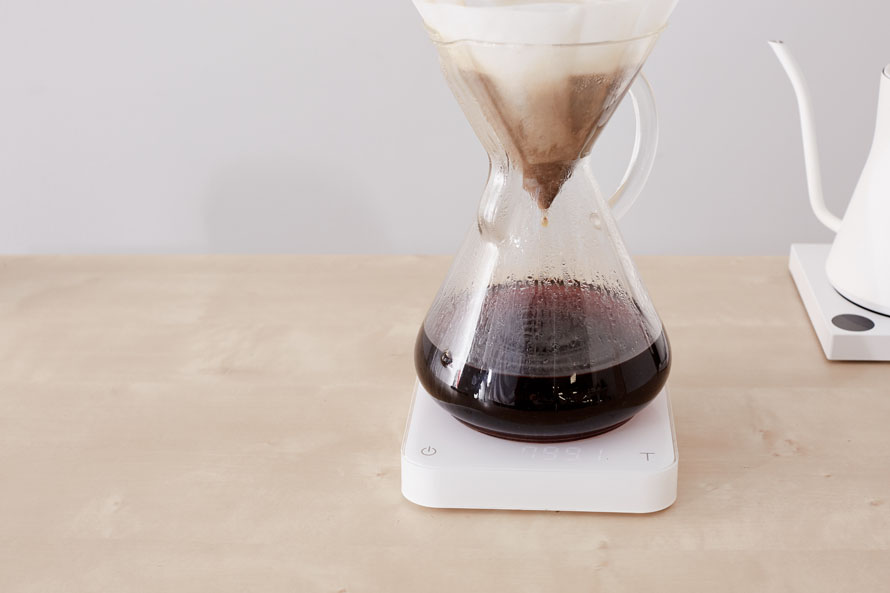Understanding Coffee Brewing with Your Chemex
How to brew with your Chemex, using an explanation of extraction, strength, and the variables you can use to make better coffee.
When it comes to pour over coffee there isn’t a brewer that has stood the test of time quite like the Chemex. Its Bauhaus design and light-bodied brews both appealed to American sensibilities at just the right time, and since its introduction in the 1940s it’s weathered as many coffee trends as you could count. Understanding how to work with your Chemex, and more specifically how to take advantage of its proprietary filters, can take some time and practice, but the rewards will be exceptional flavor clarity and a delicate body that you won’t find in any other paper-filtered brewer. This article isn’t meant to be a how-to guide so much as an introduction to understanding what’s really happening in your brewer, with the goal being that you’ll leave prepared to make more intentional decisions as you get closer and closer to the perfect Chemex coffee.
If you haven’t already, check out our Basic Brewing Principles guide where we detail the fundamentals of good coffee, good water, and good recipes. Or, if you’re interested in these concepts in a general sense instead of specifically for your Chemex, take a gander at our Intermediate Brewing Principles.
Brewing is Extraction
Regardless of how you brew your morning joe, making coffee is really the process of extraction. A series of physical and chemical interactions are set off when coffee and water mix—water washes coffee oils and fines away from the surface of your grounds, and then pulls flavor out of those grounds by dissolving (via dissolution and hydrolysis) most of the extractable compounds in the roasted beans. As this happens, water holds on to those extracted coffee materials when it flows into your Chemex and just like that we get brewed coffee! The water-soluble compounds in solution will give your coffee its flavor, while the oils and fines washed away from the surface of your grounds will typically define the body and texture of your brew.

The concentration and variety of different soluble and insoluble compounds that end up in your Chemex will change constantly during the brewing process. This happens because different chemical compounds in your roasted coffee (like organic acids, simple sugars, and more complex carbohydrates) all dissolve and extract at different and predictable rates; the first few drips out of your Chemex filter will be highly concentrated, excessively rich, and full of lively organic acids, while the end of your brew will be dilute, astringent, and contain difficult-to-dissolve compounds (like those more complex carbohydrates) that require ample time and temperature to dissolve. Most importantly, the predictable rate and order in which these flavors dissolve means that we get some influence over what our brewed coffee tastes like, as well as giving us a baseline to be able to assess our extraction as either under-extracted (we removed too little of the soluble material), over-extracted (we removed too much of the soluble material), or ideally extracted (we removed just the right amount of the soluble material).
How to Judge Your Extraction
If you were to dive into the science of coffee extraction you would quickly come across all kinds of numbers, standards, and formulas made for measuring and assessing the quality of your brew. Though quantitative data can be a helpful way to communicate precise information from one person (with the necessary tools to measure and understand the measurement) to another person (with the same tools and understanding), any coffee professional should be able to tell you that you don’t taste numbers, measurements, or extraction percentages, you taste coffee! Since we know that the flavors in our mug are influenced by the relative extraction we achieve, how do we know if our brew is over-extracted, under-extracted, or just right? By taste! There are some flavors that tend to consistently come through at different levels of extraction that you can look out for as you’re learning to dial in your recipes.

Under-extracted coffee will likely taste sour, salty, or overbearingly acidic. The early stage of extraction contains most all of the acids that will be extracted, as well as some bitter compounds (like caffeine) that can be overwhelming when left overconcentrated and unbalanced by the flavors that will extract later in the brew.
Over-extracted coffee will likely taste bitter feel unpleasantly astringent. Many of the flavors extracted late in a brew are bitter in taste, pushing the flavor balance in that direction quickly. Also, there’s very little extractable material in ground coffee late in the brewing process, so the liquid coffee flowing out of your brewer at this point will be thin and dilute, contributing to the lower strength of an over-extracted brew.
Ideally extracted coffee should be balanced and flavorful, with your Chemex highlighting clarity in the cup and an acidity that complements the flavors of your brew. This can mean sweet and brimming with fruit flavors, deep and rich with chocolatey goodness, or complex and alluring with savory complexion.
If you’re not a confident taster right now that’s totally okay! Tasting is a skill you can learn, and with a little trial and error you’ll be able to start judging your extraction accurately enough to make educated decisions about how to adjust your recipe for a better brew.
The Importance of Strength
A quality extraction is only truly successful when partnered with an appropriate strength in your brew. Our ability to taste coffee well relies on those dissolved flavors to be at a concentration suited to our palate—too much flavor in solution and our taste buds become overwhelmed and uncooperative, while too little flavor leaves a beverage to come across as dilute and unfulfilling.

In your Chemex, assuming that your dose and grind setting are in the generally accepted range for pour over brewing, your strength will always end up in a range that your palate and brain can handle. However, if you want more control over manipulating that strength up or down, we’ll talk soon about how to fine-tune your strength to make sure those flavors get to live up to their full potential.
Mastering Your Chemex
There are so many variables that go into brewing up a top-notch cup. While it will take some time to get a feel for how to manage the variables that you can’t control directly, you can at least have confidence in knowing that you still get to determine your own coffee destiny by learning a little about a few of the variables that you can control. Brewing with your Chemex is, in large part, about understanding the role of the Chemex Bonded filters and how to to capitalize on the flavor clarity that they provide.
You won’t find a recipe list or a step-by-step how-to below, but hopefully you can use these explanations as a guide to understanding how you can update parts of your recipe to make coffee better with every brew.
Brew ratio is the amount of roasted coffee and brew water you use to make a single pot of coffee. In the Chemex you can expect to see most recipes in the range of 1g of ground coffee for 15–17ml of water used, which will directly impact the strength and total extraction significantly. Extraction and strength will be inversely correlated here, meaning that the higher the extraction you achieve through your brew ratio the lower the total potential for strength becomes.
One of the hallmark features of Chemex coffee is its light body, which we can attribute directly to the thick Chemex Bonded filter paper used traditionally with the Chemex. Thanks to factors like the weight of the filter paper, the Chemex Bonded filters trap more coffee oils and hold back more superfine particles than any other paper filters, making the strength of our brew one of the only factors we can influence to adjust the weight or texture of our coffee. While your Chemex won’t ever make coffee that has body like a french press (or even a V60 if we’re being honest), finding a way to produce high-strength drip coffee with a balanced extraction is why I personally prefer brewing a tighter brew ratio (1g coffee per 15mL water) on the Chemex compared to many other pour over drippers (with which I lean more toward 1g coffee per 17mL water).
The Grind setting that you choose will also have a significant impact on extraction yield and a lesser impact on potential for strength, but in this instance the results will be directly correlated. As you grind finer and finer you increase the rate at which you’ll extract the coffee, and you’ll also slow down the speed at which water is able to move through the bed of grounds and the brewer to a certain degree; the Chemex Bonded filter comes into play here again, acting as a more significant flow restrictor than other paper filters, meaning that you’ll typically need to grind coarser than you might expect in other cone-shaped brewers. Depending on your batch size you’ll likely want to grind to a consistency slightly finer than kosher salt, and you can expect that as you scale your batch size up or down that you’ll need to adjust your grind setting (coarser or finer, respectively) to achieve similar overall extraction yields.

The Temperature of your water will relate directly to your rate of extraction, cooler water extracting slower and hotter water extracting faster. The general standard for brewing says to use water 195°F–205°F (90.5°C–96°C), but there are lots of folks who prefer hotter or colder water for various reasons. Thanks to the broad open area at the top of the brewing cone you can expect the Chemex to lose heat faster than many other brewers, which can be accounted for by keeping your brew water a bit warmer in the kettle than you hope for it to be ultimately in your brewing slurry.
Your total Contact Time in the Chemex will be related not only to your grind setting, but also directly influenced by the rate at which you introduce water to your brewer. A low-and-slow pouring style will let water mosey its way through the bed of coffee, extending your contact time and likely producing a slightly higher-extraction brew. Conversely, an aggressive pouring style out of the kettle and a large volume of water on top of your bed of grounds will increase the flow rate of your brew water, lending itself to a brighter extraction. Regardless of how you implement this in your brewing, always remember that more time means more extraction. Learning to balance your brew ratio, grind setting, and water flow rate is really the key to managing your Chemex’s contact time and, ultimately, your total extraction.
Get Brewing!
You can read all of the brewing theory out there and it wouldn’t make a difference if you never get your hands on a kettle, so get brewing! Hopefully now with a little understanding of extraction and strength, guidelines for how to taste and assess your brew, and an overview of the variables you can influence in your Chemex, you’re prepared to go forth and get to work on making mind-blowing brews for you and yours time and time again.
Happy brewing, y’all.



